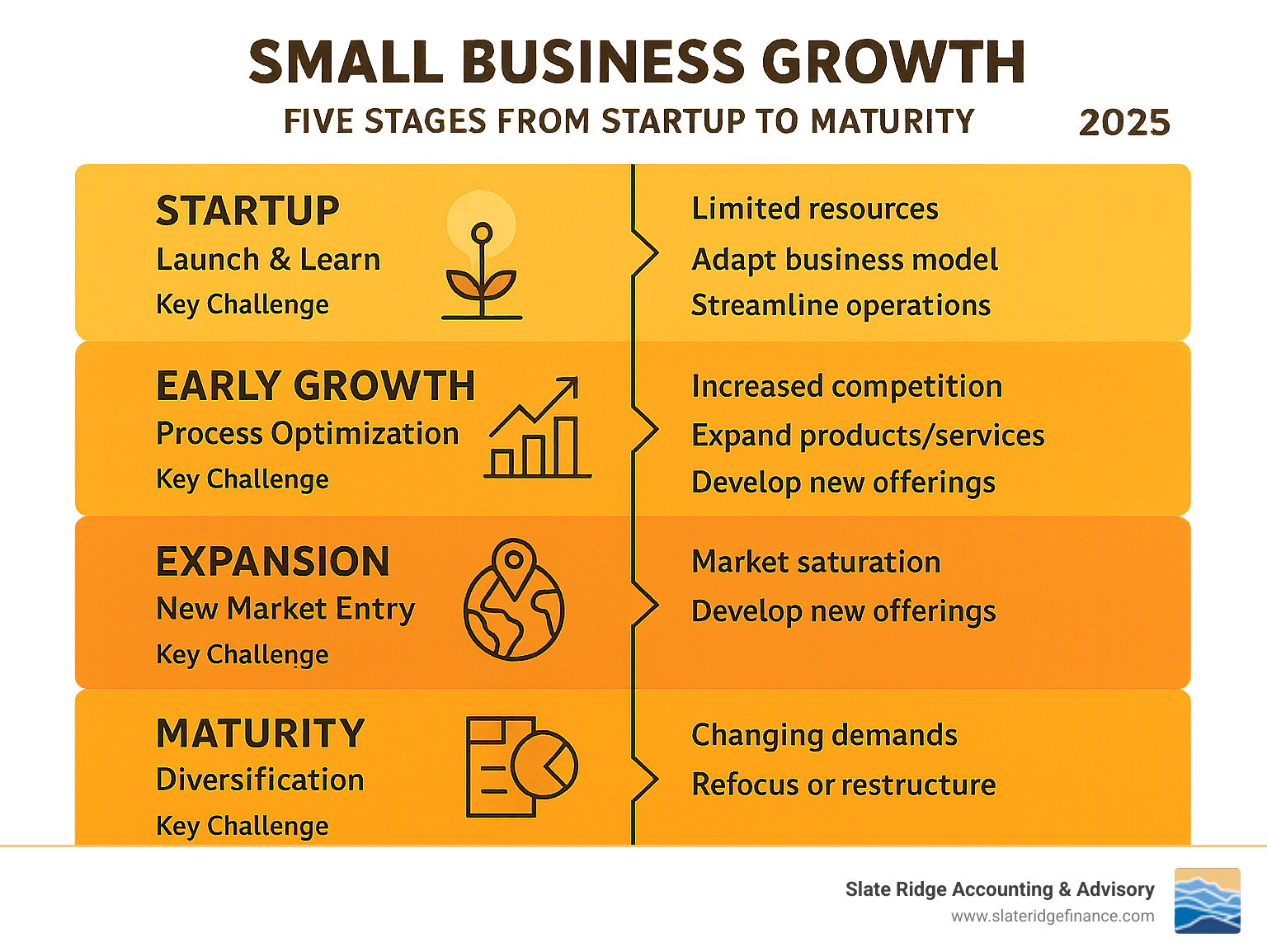Why Smart Business Growth Strategies Are Essential for Today's Market
Business growth strategies are planned approaches that help companies increase revenue, expand market share, and achieve sustainable success. In today's competitive landscape, only 25% of companies manage to grow sustainably over time - making the right strategy crucial for survival.
Here are the main types of business growth strategies you can use:
Core Growth Models (Ansoff Matrix):
- Market Penetration - Sell more of your current products to existing customers (lowest risk)
- Market Development - Take existing products to new markets or customer segments (medium risk)
- Product Development - Create new products for your current customers (medium risk)
- Diversification - Launch new products in new markets (highest risk, highest reward)
Advanced Growth Approaches:
- Strategic Partnerships - Team up with other businesses to access new customers and resources
- Technology & Innovation - Use automation, AI, and digital tools to improve efficiency and reach
- Acquisition Growth - Buy other companies to rapidly expand capabilities and market presence
Types of Growth by Method:
- Organic Growth - Expand using internal resources and operations
- Strategic Growth - Develop long-term initiatives and partnerships
- Internal Growth - Optimize existing processes and systems
- Acquisition Growth - Grow through mergers, partnerships, or buyouts
The key to success is choosing strategies that match your business model, available resources, and market conditions. Companies that grow in all directions over ten years have double the chance of outperforming their competitors.
But here's what many business owners miss: 80% of growth comes from maximizing your core business first. Before chasing new markets or products, focus on serving your existing customers better and capturing more of your current market.

How to Develop a Winning Growth Plan
Creating a winning business growth strategy starts with one simple truth: companies with written plans are 260% more likely to launch successfully and 30% more likely to grow. That's not just a nice-to-have statistic—it's your competitive edge waiting to be claimed.
Think of your growth plan as your business GPS. Without it, you're driving blind through unfamiliar territory. But with a solid plan in place, you'll know exactly where you're going, how to get there, and when you've arrived.
At Slate Ridge Accounting & Advisory, we've seen how the right planning transforms ambitious dreams into measurable results. We help our clients track the metrics that matter and forecast growth with confidence, turning those "what if" conversations into "when we achieve this" strategies.
Download HubSpot's Free Business Growth Strategy Template

Conduct In-Depth Market Research
Before you make any big moves, you need to understand the game you're playing. Market research isn't just about collecting data—it's about finding the insights that will shape every decision you make.
Start with a SWOT analysis to get crystal clear on your strengths, weaknesses, opportunities, and threats. This gives you an honest snapshot of where you stand today. Then dive into competitor analysis—not to copy what they're doing, but to find the gaps they're missing and the opportunities they're leaving on the table.
Your customers hold the keys to your next breakthrough. Customer surveys and feedback sessions reveal what they truly value, what frustrates them, and what they wish existed but doesn't yet. These conversations often spark the best product improvements and new service ideas.
Don't forget to keep your finger on the pulse of industry trends. The businesses that thrive are the ones that see shifts coming before their competitors do. They position themselves for tomorrow's opportunities while others are still figuring out yesterday's challenges.
This research phase is where you identify growth opportunities that align perfectly with your capabilities and market demand. It's the foundation that makes everything else possible.
More info about our advisory services
Set Clear, Measurable Goals
Once you understand your market, it's time to chart your course. Vague goals like "grow the business" won't cut it. You need SMART goals that give you a clear target to aim for.
Make your goals specific by defining exactly what success looks like. Instead of "increase sales," aim for "increase Product X sales by 15% in the Northeast region." Make them measurable so you'll know when you've hit the mark. Keep them achievable—ambitious enough to stretch you, but realistic enough to maintain momentum.
Your goals must be relevant to your overall mission and time-bound with clear deadlines. This creates the urgency that turns plans into action.
Balance your financial targets like revenue growth and profit margins with non-financial metrics such as customer base expansion, market share, and brand awareness. Both types of goals work together to create sustainable, long-term success.
Monitor KPIs and Adapt
Creating a plan is just the beginning. The real magic happens when you track your progress and adjust your approach based on what the data tells you. Your Key Performance Indicators become your strategic dashboard, showing you exactly how your growth strategy is performing.
Focus on the metrics that matter most: Customer Acquisition Cost tells you how efficiently you're gaining new customers, while Customer Lifetime Value reveals the long-term value of those relationships. Track your churn rate to understand retention, monitor your revenue growth rate to measure momentum, and watch your market share to see how you're performing against competitors.
The most successful businesses stay agile. They test new approaches on a small scale before rolling them out widely. They're ready to pivot when market conditions change or when the data reveals a better path forward.
Your growth strategy isn't set in stone—it's a living document that evolves with your business and your market. The companies that accept this continuous improvement mindset are the ones that turn good plans into great results.
Read our latest insights on the blog
The Ansoff Matrix: Four Core Growth Models
When we talk about business growth strategies, the Ansoff Matrix stands out as one of the most practical frameworks for making smart expansion decisions. Developed by H. Igor Ansoff back in the 1950s, this simple yet powerful tool helps us visualize different paths for growth based on what we're selling and who we're selling to.
Think of it like a roadmap with four different routes to your destination. Each route has its own scenery, challenges, and level of difficulty. The matrix shows us four possible product-market combinations for growth, each carrying different levels of risk. What makes this framework so valuable is how it helps with risk assessment - it clearly illustrates that venturing into completely unknown territory (new products for new markets) is naturally riskier than selling more of what we already do well to customers who already know and trust us.

Here's how the four strategies compare in terms of risk and focus:
| Strategy | Risk Level | Focus | Typical Tactics |
|---|---|---|---|
| Market Penetration | Low | Existing products, existing markets | Competitive pricing, loyalty programs, increased promotion, improving customer service, enhancing product features |
| Market Development | Medium | Existing products, new markets | Geographic expansion, targeting new customer segments, finding new distribution channels, adapting marketing messages |
| Product Development | Medium | New products, existing markets | Product modifications, line extensions, R&D investment, gathering customer feedback, innovation based on current customer needs |
| Diversification | High | New products, new markets | Related diversification (similar industries), unrelated diversification (completely different markets), strategic partnerships, acquisitions |
Market Penetration: A Low-Risk Business Growth Strategy
Market penetration is like perfecting your favorite recipe before trying to cook something completely new. This strategy focuses on selling more of your existing products to your existing markets - and it's typically the lowest-risk approach to growth.
The beauty of market penetration lies in its simplicity. You already know your product works, you understand your customers, and you've got proven systems in place. Now you're just looking to capture a bigger slice of the pie you're already serving.
Common tactics include competitive pricing to undercut rivals, creating loyalty programs that keep customers coming back, and ramping up your promotional efforts. You might also focus on improving customer service or adding small improvements to your existing products that make them more attractive than competitors' offerings.
This approach works particularly well when your market isn't saturated and there's still room to grow. It's often the first strategy businesses should consider because it builds on your existing strengths rather than forcing you to learn entirely new skills.
Market Development: Expanding Your Horizons
Market development is about taking what you do well and introducing it to new audiences. You're keeping your existing products but finding new markets to sell them in - think of it as expanding your territory.
This strategy opens up exciting possibilities: geographic expansion into new cities, states, or even countries; targeting completely new customer segments who might benefit from your products in ways you hadn't considered; or finding new distribution channels that put your products in front of fresh eyes.
According to a 2023 Forbes survey, many ambitious small businesses are actively pursuing market development strategies, recognizing the potential for significant growth when you can successfully introduce proven products to untapped markets.
The key to successful market development is understanding that while your product stays the same, everything else might need to change. Your marketing messages, distribution methods, and even pricing might need adjustment to resonate with these new markets.
Product Development: Innovating for Your Current Customers
Product development flips the script - instead of finding new customers, you're creating new products for your existing markets. This strategy leverages your deep understanding of your current customers' needs and preferences.
Since you already have strong relationships with your customer base, you can gather valuable feedback about what they'd like to see next. This might involve product modifications to better serve their evolving needs, line extensions that complement your existing offerings, or investing in R&D to create something genuinely innovative.
The advantage here is that you're not starting from scratch with marketing and customer acquisition. Your existing customers already trust you, so they're more likely to try your new products. However, product development does require investment in research, development, and sometimes new operational capabilities.
Customer feedback becomes absolutely crucial in this strategy. Your existing customers are your best source of insight into what new products might succeed in your market.
Diversification: Venturing into New Territory
Diversification is the boldest move on the Ansoff Matrix - creating new products for new markets. It's like deciding to open a completely different type of restaurant in a town you've never been to. This strategy carries the highest risk but also offers the potential for high reward.
There are two main types of diversification. Related diversification involves expanding into markets or products that have some connection to your current business - like a bakery starting to cater events. Unrelated diversification means venturing into completely different territory - like that same bakery deciding to offer accounting services.
While diversification can seem exciting, it requires careful consideration. You're essentially starting two new ventures at once: learning a new market and developing new products. This demands significant resources, both financial and operational, and there's a higher chance things won't go as planned.
However, when diversification works, it can provide valuable protection against market downturns in your core business and open up entirely new revenue streams. The key is having a solid strategic rationale and sufficient resources to weather the learning curve.
For more insights on strategic growth approaches and how to evaluate which path makes sense for your business, check out Strategies for Diversification - Ansoff's original work that laid the foundation for modern strategic planning.
The Financial Backbone of Your Growth Strategy
Here's the truth about business growth strategies: even the most brilliant plans fall apart without solid financial foundations. Growth requires investment, and that investment needs to be carefully planned and managed. It's like building a house – you can have the most beautiful architectural plans in the world, but without a strong foundation, everything crumbles.
At Slate Ridge Accounting & Advisory, we've seen too many businesses stumble not because their growth strategies were wrong, but because they didn't have the financial clarity to execute them properly. That's exactly why our virtual bookkeeping, financial clean-up, and advisory services focus on giving you the financial backbone you need to pursue growth with confidence.
The reality is that even when sales are increasing, the cost of servicing that growth can actually drain your working capital and threaten your business if not managed properly. We help you track KPIs and forecast growth, ensuring your ambitious plans are financially sound from day one.
Learn about our virtual accounting services
Aligning Your Budget with Growth Goals
Your budget isn't just a spreadsheet filled with numbers – it's your growth strategy translated into financial terms. Think of it as your roadmap that shows exactly where every dollar is going to work hardest for your expansion goals.
When we talk about capital allocation, we're looking at the big investments: new equipment, technology upgrades, or facility expansions that will support your growth. These aren't just expenses; they're investments in your future capacity.
Then there are the operational expenses that come with growth. More customers often means more staff, higher utility bills, increased supplies, and other day-to-day costs that can sneak up on you if you're not prepared.
Your marketing budget deserves special attention because it's often the engine that drives new customer acquisition. Are you dedicating enough resources to attract those new customers and promote your expanded offerings? This isn't just about spending money – it's about investing strategically in your market presence.
The key is ROI analysis – for every dollar you spend on growth initiatives, what return do you realistically expect to see? This helps you prioritize investments with the highest potential impact and avoid throwing good money after questionable opportunities.
Financial forecasting becomes your crystal ball here, allowing you to project future revenues and expenses so you can ensure you have the resources to fuel your growth without running into cash flow problems down the road.
Securing Funding and Managing Resources
Let's be honest – for most businesses, especially smaller ones, securing funding for growth feels like climbing a mountain. But there are several paths to the summit, and the right choice depends on your specific situation and growth goals.
Business loans from traditional banks or credit lines can provide the capital you need, especially if you have solid financials and a clear growth plan. Investors like angel investors or venture capitalists might be the right fit if you're planning aggressive expansion and can offer them the returns they're looking for.
There's also bootstrapping – growing using only your internal profits and cash flow. While this might seem slower, it actually promotes incredible financial discipline and keeps you fully in control of your business decisions.
But here's where many businesses get tripped up: securing funding is only half the battle. Working capital management and smart cash flow management are what keep you moving forward. You need enough liquidity to cover your short-term obligations while still investing in your future.
Good cash flow management is essential because even profitable growth can drain your working capital if you're not careful. That's why maintaining financial discipline throughout your growth journey isn't just smart – it's absolutely critical for long-term success.
See our FAQ for more financial tips
Frequently Asked Questions about Business Growth
When it comes to business growth strategies, we hear the same thoughtful questions from our clients time and time again. Let's tackle the ones that come up most often.
What are the main types of business growth?
Business growth comes in different flavors, and understanding these types helps you choose the right approach for your situation. Think of them as different pathways to the same destination.
Organic growth is like growing a garden from seeds you planted yourself. You're using your company's internal resources and operations to expand - maybe by increasing sales, improving efficiency, or developing new products for your existing customers. Picture a bakery that starts making more bread by streamlining their process or adding a second oven with money they've saved up.
Strategic growth takes a longer view. It's about forming partnerships, alliances, or making moves that position your business for future success. This approach requires patience and planning, but it can open doors you couldn't reach alone.
Internal growth focuses on getting more from what you already have. Maybe you're cutting wasteful spending, automating repetitive tasks, or finding ways to serve customers more efficiently. It's about working smarter, not just harder.
Acquisition growth is the fastest route - you're essentially buying someone else's growth by purchasing other businesses or forming mergers. It's like adding a whole new room to your house instead of renovating the existing ones.
The beautiful thing is, you don't have to pick just one. Many successful businesses blend these approaches to create their own unique growth recipe.
How do I measure the success of my growth strategy?
Here's the truth: if you can't measure it, you can't manage it. Measuring growth success means tracking your Key Performance Indicators (KPIs) against those SMART goals you set at the beginning.
Your measurement toolkit should include both financial metrics and non-financial metrics. The financial ones are usually the most obvious - revenue growth, profit margins, customer acquisition cost, customer lifetime value, and return on investment for specific initiatives. These numbers tell you if your growth is actually profitable.
But don't stop there. Non-financial metrics give you the full picture. How's your market share growing? Are customers more satisfied? Is your brand becoming more recognizable? What about customer retention rates and employee satisfaction? Even website traffic and lead generation numbers matter.
At Slate Ridge, we help our clients track these KPIs and forecast growth, turning all those numbers into actionable insights. The key is consistently monitoring these metrics and comparing them to your specific goals. This way, you'll know what's working, what needs tweaking, and when to pivot your strategy.
How does a business model influence growth strategy?
Your business model is like your company's DNA - it determines how you create value, deliver it to customers, and capture revenue. And just like DNA influences what you look like, your business model shapes which business growth strategies will work best for you.
Take a subscription-based software company. Since they thrive on recurring revenue, their growth strategies naturally focus on keeping customers happy (to reduce churn), developing new features (to increase value), and finding new market segments that need their solution.
A traditional retail business operates differently. They rely on physical locations and product sales, so their growth strategies might emphasize attracting more customers to existing stores, opening new locations, or introducing new product lines.
An e-commerce business that sells directly to consumers has yet another playbook. They'll likely focus on digital marketing, expanding their product range, and forming strategic partnerships with logistics providers or complementary brands.
Understanding your business model's strengths and limitations is crucial for choosing growth strategies that aren't just ambitious, but actually aligned with how you operate. It's the difference between swimming with the current and fighting against it.
Conclusion: Plan Your Path to Sustainable Success
Achieving sustainable business growth isn't something that just happens by chance. It's the result of careful planning, smart choices, and being willing to adapt when things change. Throughout this guide, we've walked through how the Ansoff Matrix can help you make better decisions about your products and markets, and how advanced strategies like partnerships, technology adoption, and strategic acquisitions can speed up your progress.
But here's what really matters: none of these strategies will work without solid financial foundations. Your growth needs to be more than just fast - it needs to be healthy and stable too.
The modern approach to business growth strategies is all about staying flexible, making decisions based on real data, and keeping your focus split between serving your customers better and building stronger internal capabilities. It's knowing when to perfect what you already do well, when to explore new opportunities that make sense for your business, and when it's time to make those big, bold moves that can transform everything.
Think of growth like building a house. You can have the most beautiful architectural plans in the world, but without a strong foundation, everything comes crashing down. That's where the financial side becomes absolutely crucial - and honestly, it's where many businesses stumble.
At Slate Ridge Accounting & Advisory, we've seen how the right financial support can make the difference between growth that stresses your business and growth that strengthens it. Our cloud-based accounting, virtual bookkeeping, financial clean-up, and advisory services aren't just about keeping your books balanced. We're about giving you the modern, personalized, and industry-custom financial solutions you need to track your KPIs with confidence, forecast your growth accurately, and make strategic decisions that actually work.
Whether you're just starting to think about growth or you're ready to scale rapidly, we're here to help you steer the financial complexities that come with expansion. Let us be your partner in writing the next chapter of your growth story - one that's built on solid financial ground and designed for long-term success.
Ready to get started?
Book a free consultation today and let’s explore how Slate Ridge can support your business with expert accounting that’s accurate, timely, and built around your goals.






